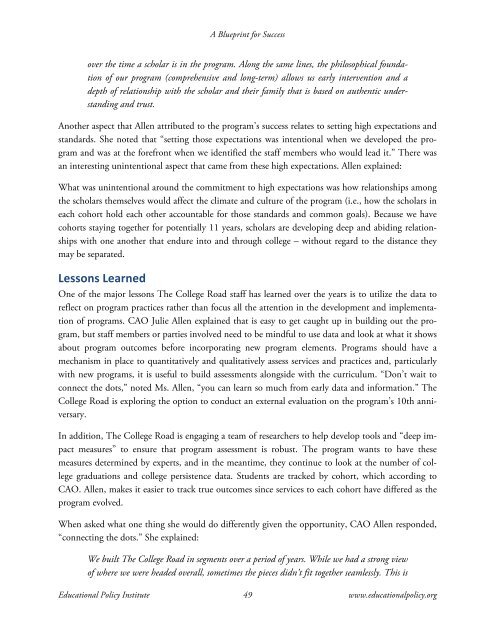A BluePrint for Success: Case Studies of Successful - Educational ...
A BluePrint for Success: Case Studies of Successful - Educational ...
A BluePrint for Success: Case Studies of Successful - Educational ...
Create successful ePaper yourself
Turn your PDF publications into a flip-book with our unique Google optimized e-Paper software.
A Blueprint <strong>for</strong> <strong>Success</strong><br />
over the time a scholar is in the program. Along the same lines, the philosophical foundation<br />
<strong>of</strong> our program (comprehensive and long-term) allows us early intervention and a<br />
depth <strong>of</strong> relationship with the scholar and their family that is based on authentic understanding<br />
and trust.<br />
Another aspect that Allen attributed to the program’s success relates to setting high expectations and<br />
standards. She noted that “setting those expectations was intentional when we developed the program<br />
and was at the <strong>for</strong>efront when we identified the staff members who would lead it.” There was<br />
an interesting unintentional aspect that came from these high expectations. Allen explained:<br />
What was unintentional around the commitment to high expectations was how relationships among<br />
the scholars themselves would affect the climate and culture <strong>of</strong> the program (i.e., how the scholars in<br />
each cohort hold each other accountable <strong>for</strong> those standards and common goals). Because we have<br />
cohorts staying together <strong>for</strong> potentially 11 years, scholars are developing deep and abiding relationships<br />
with one another that endure into and through college – without regard to the distance they<br />
may be separated.<br />
Lessons Learned<br />
One <strong>of</strong> the major lessons The College Road staff has learned over the years is to utilize the data to<br />
reflect on program practices rather than focus all the attention in the development and implementation<br />
<strong>of</strong> programs. CAO Julie Allen explained that is easy to get caught up in building out the program,<br />
but staff members or parties involved need to be mindful to use data and look at what it shows<br />
about program outcomes be<strong>for</strong>e incorporating new program elements. Programs should have a<br />
mechanism in place to quantitatively and qualitatively assess services and practices and, particularly<br />
with new programs, it is useful to build assessments alongside with the curriculum. “Don’t wait to<br />
connect the dots,” noted Ms. Allen, “you can learn so much from early data and in<strong>for</strong>mation.” The<br />
College Road is exploring the option to conduct an external evaluation on the program’s 10th anniversary.<br />
In addition, The College Road is engaging a team <strong>of</strong> researchers to help develop tools and “deep impact<br />
measures” to ensure that program assessment is robust. The program wants to have these<br />
measures determined by experts, and in the meantime, they continue to look at the number <strong>of</strong> college<br />
graduations and college persistence data. Students are tracked by cohort, which according to<br />
CAO. Allen, makes it easier to track true outcomes since services to each cohort have differed as the<br />
program evolved.<br />
When asked what one thing she would do differently given the opportunity, CAO Allen responded,<br />
“connecting the dots.” She explained:<br />
We built The College Road in segments over a period <strong>of</strong> years. While we had a strong view<br />
<strong>of</strong> where we were headed overall, sometimes the pieces didn’t fit together seamlessly. This is<br />
<strong>Educational</strong> Policy Institute 49 www.educationalpolicy.org




